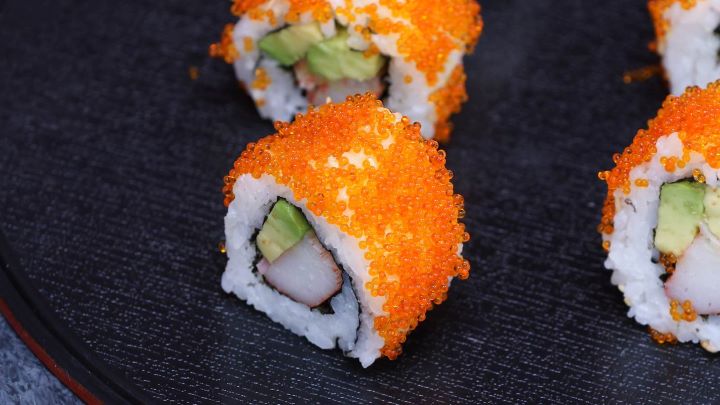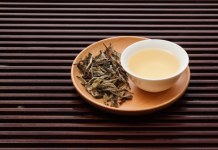Sushi lovers, have you ever come across those tiny, colorful beads adorning your favorite rolls and wondered what they are? Those delightful little orbs are known as masago, and they’re a tiny but powerful ingredient in the world of sushi and Japanese cuisine. In this blog, we’ll dive deep into the captivating world of masago.
What Is Masago?
Masago, pronounced “mah-sah-goh,” is the Japanese term for the processed roe (fish eggs) of the capelin fish, specifically the Greenland or Atlantic capelin (Mallotus villosus). These small, orange-hued eggs are often used as a topping or garnish in sushi, but their culinary applications go far beyond this.
The Beauty of Tiny Eggs: Masago Types
- Orange Masago: This is the most common type and is used extensively in sushi. It has a mild, slightly sweet flavor and is often used for its vibrant orange color, which adds a visual pop to dishes.
- Black Masago: Black masago is the result of adding squid ink to the eggs. It has a more intense, briny flavor and is used for both taste and visual contrast.
- Wasabi Masago: Infused with wasabi, this variety provides a spicy kick to dishes. It’s perfect for those who enjoy a little heat in their sushi.
- Golden Masago: This type is colored with a mixture of turmeric and paprika, giving it a bright golden hue. It has a milder flavor and is often used to create aesthetically pleasing sushi.
The Role of Masago in Japanese Cuisine:
- Sushi Topping: The most common use of masago is as a sushi topping. Its small, vibrant eggs are sprinkled over rolls, adding both a visual and textural element. They create a satisfying “pop” when bitten into.
- Nigiri Sushi: Masago is also used in the preparation of nigiri sushi, where it’s formed into a small, oblong mound and draped over a small bed of rice.
- Sashimi Garnish: It can be used as a garnish for sashimi, adding an elegant touch to these thinly sliced pieces of raw fish.
- Rice Dishes: Beyond sushi, masago is often used to garnish rice dishes, such as chirashi sushi, where it’s scattered over a bowl of seasoned rice and fish.
Health Benefits of Masago:
Masago, the delightful roe of the capelin fish, is not just a colorful garnish for sushi – it’s a tiny nutritional powerhouse that offers a range of health benefits. Let’s explore the nutritional content and health advantages of masago.
Rich in Protein:
Masago is a superb source of high-quality protein. In just one ounce (28 grams) of masago, you can find around 6 grams of protein. Protein is essential for numerous bodily functions, including muscle growth, tissue repair, and the production of enzymes and hormones.
Omega-3 Fatty Acids:
Masago is a notable source of omega-3 fatty acids. These essential fats have been linked to a variety of health benefits, including:
- Heart Health: Omega-3s can help reduce the risk of heart disease by lowering blood pressure and triglyceride levels.
- Brain Function: Omega-3s play a crucial role in brain development and may help enhance cognitive function and reduce the risk of neurological disorders.
- Inflammation: These fatty acids possess anti-inflammatory properties, which can be beneficial in managing chronic inflammatory conditions.
Vitamins and Minerals:
Masago contains various vitamins and minerals, including:
- Vitamin B12: This vitamin is essential for nerve function and the production of red blood cells.
- Iodine: Iodine is necessary for thyroid function and overall metabolic health.
- Vitamin D: Important for calcium absorption and maintaining strong bones.
- Selenium: An antioxidant mineral that helps protect cells from damage.
Low in Calories:
If you’re looking to maintain a calorie-conscious diet, masago can be an excellent choice. One ounce (28 grams) of masago contains approximately 40 calories. This makes it a low-calorie addition to various dishes.
Aid in Weight Management:
The protein content in masago can contribute to a sense of fullness and help control appetite. Including masago in your meals might assist in weight management by reducing overall calorie intake.
Skin Benefits:
The omega-3 fatty acids found in masago can support skin health. They help maintain the skin’s moisture barrier, keeping it hydrated and potentially reducing skin conditions like dryness and flakiness.
Brain Health:
The omega-3s in masago, particularly docosahexaenoic acid (DHA), play a critical role in brain health. DHA is a major component of brain tissue and is linked to cognitive function and reducing the risk of neurological disorders.
Heart Health:
Omega-3s are known for their heart-protective properties. They can reduce blood pressure, lower triglycerides, and decrease the risk of heart disease. Including masago in a heart-healthy diet may have beneficial effects on cardiovascular health.
Anti-Inflammatory Properties:
The omega-3 fatty acids in masago possess anti-inflammatory properties. Chronic inflammation is associated with various health issues, so including foods like masago in your diet may help manage inflammation.
Potential Mood Benefits:
Omega-3s have been linked to mood regulation and mental health. They may help reduce the risk of depression and anxiety and promote an overall sense of well-being.
Caveats:
While masago offers several health benefits, it’s essential to enjoy it in moderation. The sodium content in some preparations can be relatively high, so be mindful of your salt intake. Additionally, if you have allergies to fish or seafood, be cautious when consuming masago.
Culinary Delights with Masago:
- Masago Sushi: This is the classic preparation, where masago is used as a topping or garnish for various types of sushi rolls. The tiny eggs provide a burst of flavor and color.
- Sushi Bowls: Create a sushi bowl by combining seasoned rice, your favorite fish or seafood, and a generous sprinkling of masago for an explosion of flavor and texture.
- Sashimi Complement: Elevate your sashimi platter by using masago as a garnish. Its tiny pearls add visual appeal and a pleasing crunch.
- Spicy Rolls: Wasabi masago is an excellent choice for spicing up sushi rolls. Its heat pairs well with creamy ingredients like avocado and mayonnaise.
- Salad Toppings: Get creative by adding a dash of masago to salads. The pop of color and mild seafood flavor can make your salads extraordinary.
Where to Find Masago:
Masago is readily available in Asian grocery stores, particularly those with a well-stocked sushi section. You can often find it in the frozen or refrigerated seafood area. It’s also accessible in some larger supermarkets. Alternatively, you can order it online for convenient delivery to your doorstep.
Caring for Masago:
To keep masago fresh, it’s best to store it in the refrigerator. Once opened, use it within a few days. Since masago is often frozen when purchased, defrost it in the refrigerator to maintain its quality.
A Delightful Addition to Your Culinary Journey:
Masago may be tiny, but its presence in Japanese cuisine is significant. From enhancing the flavor and appearance of sushi rolls to providing a source of omega-3 fatty acids, it offers a delightful combination of taste and health benefits. So, the next time you enjoy sushi, sashimi, or a vibrant sushi bowl, savor those tiny beads of masago, and appreciate the exquisite touch they bring to your culinary adventure.
References:
https://pubmed.ncbi.nlm.nih.gov/34455321/
https://www.ncbi.nlm.nih.gov/pmc/articles/PMC3509649/













